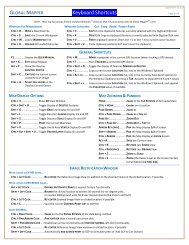Map GPS Coordinates - GPS Map Coordinates ... - Global Mapper
Map GPS Coordinates - GPS Map Coordinates ... - Global Mapper
Map GPS Coordinates - GPS Map Coordinates ... - Global Mapper
Create successful ePaper yourself
Turn your PDF publications into a flip-book with our unique Google optimized e-Paper software.
<strong>Global</strong> <strong>Map</strong>per User's Manual<br />
should use a projection specified by pressing the Projection button. If the user selects to specify an output<br />
projection and they select a zoned projection like UTM or Gauss Krueger, they will have the option on the<br />
projection selection dialog to have the best zone for the center of the output map automatically used if they<br />
select the Automatically Select Best Zone option in the Zone box on the projection selection dialog.<br />
The Setup Gridding (i.e. Tiling) button displays a dialog allowing the user to specify if and how to break up<br />
each file being converted into multiple new files. This option is only available when converting to a raster or<br />
gridded elevation format.<br />
The Setup Sample Spacing button displays a dialog allowing the user to choose to either keep the sample<br />
spacing of source raster and elevation files when converting the selected or to specify a new sample spacing to<br />
resample all of the selected input files at when performing the conversion. This option is only available when<br />
converting to a raster or gridded elevation format.<br />
The Horz Datum selection allows the user to choose the horizontal datum that each newly created output file<br />
should use. By default, each output file will use the same horizontal datum as the source file that it was<br />
created off of. Alternately, the user can specify to have all output files created in NAD27, NAD83, WGS72,<br />
or WGS84 with the appropriate offset being applied automatically.<br />
The Vertical Units selection is present only for some conversions and controls the output elevation units.<br />
The Palette selection is present only for some conversions and controls the palette, if any, used in the output<br />
files. The palette values are defined as follows:<br />
• Image Optimized Palette - The palette generated will be an optimal mix of up to 256 colors that will<br />
closely represent the full blend of colors in the source images. This option will generate the best<br />
results, but can more than double the export time required if any high color images are present in the<br />
export set. If all of the input data is palette-based and the combined palette of those files has 256<br />
colors or less, then the combined files of the input file will just be used with no additional export time<br />
being required.<br />
• Grayscale Palette - This palette consists of 256 scales of gray ranging from black to white.<br />
• DRG Optimized Palette - This palette is optimized for the exporting USGS DRG data. The palette<br />
consists of only the standard DRG colors.<br />
• DRG/DOQ Optimized Palette - As the name suggests, this palette is optimized for exporting a mixture<br />
of USGS DRG data and grayscale satellite photos (i.e. USGS DOQs). The palette consists of the 14<br />
standard DRG colors with the remaining 242 colors being a range of gray values ranging from black<br />
to white.<br />
• Halftone Palette - The palette consists of a blend of 256 colors evenly covering the color spectrum.<br />
This palette is the best choice when exporting anything but DRGs and grayscale satellite photos.<br />
• Custom Palette from File - This option allows the user to choose a .pal file describing the palette to<br />
use for the export. A .pal file should be a text file with one line per color, with the red, green, and blue<br />
color components for each color in the palette separated by a comma. You can save a .pal file for an<br />
existing palette-based file by opening the Overlay Control Center, selecting the palette-based layer,<br />
press Options, then the Transparent Color button, then selecting the option to save a color palette file.<br />
• 24-bit RGB - Create a full 24-bit color image with no palette. This will create the best resulting image<br />
but will also take the most space.<br />
• Keep Same as Source File - The new file will use the same color encoding as the source file, either<br />
palette-based, 24-bit RGB, multi-band, or grayscale.<br />
• Multi-Band Image - The new file will use be a multi-band image using the same number of bands as<br />
the input file. You will be able to choose either 8-bits or 16-bits per band.<br />
<strong>Map</strong> <strong>GPS</strong> <strong>Coordinates</strong> - <strong>GPS</strong> <strong>Map</strong> <strong>Coordinates</strong> - <strong>GPS</strong><strong>Coordinates</strong> <strong>Map</strong> 76







